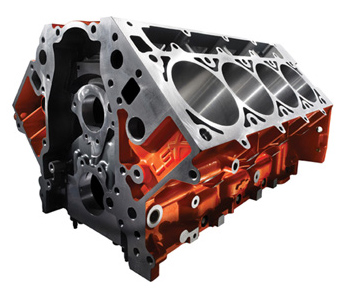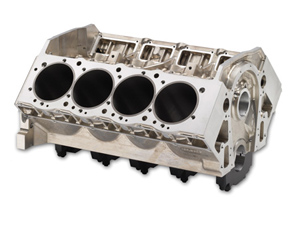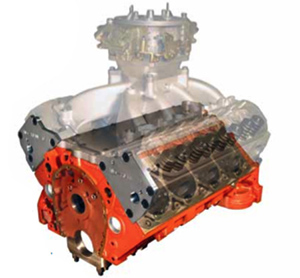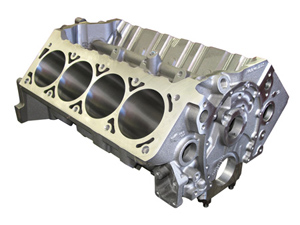By Larry Carley
Technical Editor
The foundation of every engine is the cylinder block. Whether you are rebuilding a stock engine or building up a street performance engine, a circle track engine, drag engine, marine engine or whatever, you have to start with a good, solid block that’s machinable and free from cracks and other defects. That’s becoming more and more of a challenge in recent years because good cores for popular domestic engines are getting harder and harder to find as time goes on. That’s one reason why the demand for aftermarket engine blocks has grown in recent years.
 |
| Good cores for popular domestic engines are getting harder and harder to find as time goes on. That’s one reason why the demand for aftermarket engine blocks has grown in recent years.
|
The ever-popular small block Chevy V8 was introduced way back in 1955. Millions of these engines were produced over the following half century, but time and attrition have severely depleted the number of “good” cores that are still available. The same goes for big block Chevy V8s, Ford small block V8s and vintage Chrysler Hemis. When the price of scrap metal peaked in the summer of 2008, a lot of old iron disappeared forever when it was melted down and converted into cash.
Small block Chevys, big block Chevys, small block Fords and Chrysler Hemis have all been popular with performance engine builders because of their long production runs, the availability of aftermarket performance parts, and a long history of development and refinement that allows these engines to produce significantly more horsepower and torque than their stock counterparts. But if you can’t find a good used block to start with, your only option is to start with a new block.
Aftermarket engine blocks used to be only for high-end professional racers with deep pockets. But with the introduction of many affordable cast iron and aluminum castings for popular applications, engine builders now have more options available than ever before. If you can’t find a good stock core to work with, you can start from scratch with a brand new aftermarket block.
 |
|
Billet blocks have a number of advantages
over cast aluminum blocks. One is strength. Billet blocks are much stronger than cast blocks. |
Aftermarket castings are usually superior in many ways to a stock factory casting. Critical areas of the casting such as the cylinder walls and decks may be up to twice as thick for added strength and machinability. Some aftermarket blocks also incorporate additional ribbing for added rigidity, which is especially important if you are building a high horsepower engine that will increase stress on the block. You can also choose various bore sizes, deck heights and main bore sizes with aftermarket blocks, as well as cast iron or billet steel main caps.
Aftermarket blocks with taller than stock deck heights and/or relocated camshafts can provide extra clearance for long stroker crankshafts. Everybody wants more cubic inches these days. You can easily increase the displacement of any engine by boring and stroking. But you can only stretch a stock block so far before you run out of metal between the cylinders, or clearance between the connecting rods and the oil pan rails on the sides of the block or the camshaft.
When Chevy engineers established the dimensions of the small block way back in 1955, they never dreamed that someday it might displace over 450 cubic inches. At the time, there were no plans to enlarge the displacement much beyond the original 265 cubic inches. In fact, the engine was initially planned to displace 260 cubic inches with 3.75ËÂÂ bores and a 2.93ËÂÂ stroke. But they decided to round off the stroke to an even 3 inches for a displacement of 265 cubic inches.
 |
| The Motown LS block is for those who have invested in small block Chevy components – including pulley systems – and seek an economical means of upgrading to the newer LS-series cylinder head technology.
|
As casting techniques improved, Chevy engineers realized the small block had a lot of potential for growth. They could increase the bore size and the stroke to offer more displacement and power for larger cars or more performance. The 265 soon became a 283, then a 327, then a 350 and eventually a 400, with other sizes in between (302, 307, etc.). As aftermarket stroker cranks became available, 383 and even 427 cubic inch small blocks became relatively easy and affordable to build.
The story with big block Chevys is similar, with the original 396 growing to 427, then 454 cid in stock form, only to be stretched to 506 and beyond with aftermarket stroker kits. But even that wasn’t enough, so aftermarket blocks with larger bore spacing of up to 5 inches and more now allow people to build engines with monster displacements of up to 900 cubic inches or more!
Aftermarket Blocks Are Purpose Built
Aftermarket blocks open up a lot of possibilities that are not available with stock blocks. Besides creating a fresh supply of “vintage” blocks that have been rapidly disappearing in recent years, many of these engines are purpose-built with features that make them much better suited to the rigors of racing. You can get solid blocks with no water jackets, blocks with half water jackets, or blocks with larger capacity water jackets.
For drag racing, cooling isn’t an issue. The engine usually doesn’t need much cooling capacity unless you want to circulate coolant through the block between runs to lower its temperature. For any kind of endurance racing, however, extra cooling capacity is always a plus. The more power an engine makes, the more cooling capacity it will require to manage the extra heat.
One of the features that often makes an aftermarket block a better choice than a stock block for a performance engine is redesigned cooling jackets and coolant flow through the block and heads. Opening up critical areas between the cylinders and improving coolant circulation between the block and heads can prevent hot spots that increase the risk of engine-damaging detonation and pre-ignition.
 |
|
The Motown LS small block Chevy is a hybrid of old and new technology that allows late model LS Chevy heads to be bolted to the standard Chevy block. The combo is supposed to be good
for 30 hp with no other modifications.
|
Engine oiling is another item that may be tweaked in an aftermarket block to improve oil flow. Oil galleries may be larger, restrictors may be relocated to make access easier, gallery plugs are tapped rather than press-in plugs for reliability, and so on. Even the location of the oil holes to crankshaft or camshaft journals may be relocated to improve lubrication.
If you want to minimize weight, aftermarket blocks also offer considerable weight savings if you opt for an aluminum block over a cast iron block. Aluminum costs more but can reduce the weight of the block to less than 150 lbs. depending on the engine. Most aluminum blocks use dry pressed in steel sleeves and billet steel main caps. Various deck heights and bore sizes are available to meet your needs.
Strength is critical in any performance engine, so some suppliers of aftermarket engine blocks are now offering compacted graphite iron (CGI) as an optional upgrade for certain engines. A block made of CGI rather than ordinary cast iron is a good choice for a supercharged or turbocharged engine that is running a lot of boost pressure, or an engine that is being juiced with high doses of Nitrous Oxide (NOX). One supplier told us that it’s not unusual for some Outlaw Sprint Cars to squeeze as much as 2,000 horsepower out of a small block – which can crack the block unless it’s made of CGI.
Compacted Graphite Iron roughly doubles the strength of the casting but does not add any weight. But it’s not cheap. A CGI block will cost you about 40 percent more than an ordinary cast iron block.
Another option engine builders have today is to choose a billet block. In recent years, Computer Numeric Controlled (CNC) machining has made possible a lot of things that were either too expensive or too difficult to accomplish by other means. Computer Aided Design and mapping now makes it possible to copy or design from scratch an engine block on a computer screen, then machine it from a solid chunk of billet aluminum.
Billet blocks have a number of advantages over cast aluminum blocks. One is strength. Billet blocks are much stronger than cast blocks. The tensile strength of a billet block is about a third higher than that of a 356 aluminum block. This improves rigidity, reduces block distortion and improves cylinder sealing under load.
The new SHP block is a “reasonably priced” upgrade for a street performance or entry level racing. The block is cast iron and is designed for applications up to 600 horsepower.
Another advantage of billet blocks is weight. The thickness of a billet block can be machined down in areas where strength isn’t as critical. This can shave 20 to 30 lbs. off the weight of a billet aluminum block compared to a cast aluminum block. Billet blocks can also be repaired more easily than castings by TIG welding. Finally, billet blocks can be easily customized to almost any dimensions (deck height, bore spacing, cam location, etc.).
What’s New
One of the coolest aftermarket engine blocks to make its debut this past year is World Product’s Motown LS small block Chevy. The modified small block is a hybrid of old and new technology that allows late model LS Chevy heads to be bolted to the standard Chevy block. The combo is good for 30 hp with no other modifications, says World Products.
The block uses standard Chevy SB crankshaft and ignition, and comes with larger cooling jackets that hold almost half a gallon more coolant. Special LS pistons must be used. Options include a Sportsman series block with nodular iron splayed 4-bolt mains, and a Race block with 1045 steel billet caps. Both have a 9.240" deck, 400 mains and 4.115" bores.
The “LSX” block has been available for a little over a year, and is designed for engine builders who need a stronger foundation than the stock LS block. The block is cast iron with added metal in all critical areas. The block weighs 225 lbs., which is almost double the weight of a stock aluminum LS block, but it is designed to handle over 2,000 horsepower.
World Products is also developing a 409 Chevy block that was previewed at the Performance Racing Industry show, and should be available by summer 2009. This would be a good combination with Edelbrock’s new 409 aluminum heads that were introduced not long ago. Dart’s newest offering is their Special High Performance (SHP) version of the Chevy small block. The new SHP block is a “reasonably priced” upgrade for a street performance or entry level racing. The block is cast iron (made in USA) and is designed for applications up to 600 horsepower. Deck height is 9.025" with a choice of 4.000" or 4.125" bores and 350 mains.
Dart is also offering Compacted Graphite Iron as an option for any of their cast iron engines (SB/BB Chevy and SB Ford). Dart is also doing billet blocks, CNC machined from 6061 aluminum. These include billet Chevy small blocks, big blocks with up to 5.2" bore spacing for displacements up to 800 cid, and LS blocks with custom deck heights, bore diameters and lifter/camshaft configurations.
For Chevy LS enthusiasts, GM Performance Parts sells an “LSX” version of their Bowtie LS engine block that sells for less than $2,000. This engine has been available for a little over a year, and is designed for engine builders who need a stronger foundation than the stock LS block provides. The block is cast iron with added metal in all critical areas. The block weighs 225 lbs., which is almost double the weight of a stock aluminum LS block, but it is designed to handle over 2,000 horsepower. It also has larger 4.25" bores, which allows displacements of up to 482 inches with a 4.5" stroker crank. Available deck heights include 9.200 and 9.700 inches.
ERL Performance reworks stock General Motors LS-Series aluminum blocks by machining out the OEM cylinders and installing ductile iron sleeves. Sean Ragains of ERL Performance says their “Superdeck 1” system is a good alternative for racers who already have an LS block but who don’t want to spend the money on a brand new block. Ragains said their modifications can stretch the bores out to 4.125", while significantly improving the strength and durability of the OEM block by adding reinforcing trusses to support the cylinders. “Some of our engines are putting out over 1,800 horsepower.” The Superdeck 1 modifications include either a 4 or 6 head bolts per cylinder configuration. Also available is a Superdeck 2 package that bumps the LS engine displacement up to 500 cid with a taller deck (10.2") and increased internal clearances.
CN Blocks makes both small and big block Chevy billet aluminum blocks, with bore spacings up to 5.300" now available in the Chevy BB motors. So if cubic inches is what you want, one of these blocks should certainly satisfy you need for more power.
Donovan Engineering manufactures both small and big block Chevy aluminum engines, including a raised cam version of the SB Chevy that can handle displacements up to 488 cubic inches, and a raised cam version of the BB Chevy with bore spacings up to 5.0 inches and wider pan rails that can accommodate stroker cranks up to 632 cid. They also make their “417” engine, which is a reproduction of the original 392 cid Chrysler hemi, and an aluminum Model D four cylinder flathead Ford for antique engine builders.
For diesel engine builders, Diesel Heads & Parts makes an aftermarket replacement block for General Motor’s “disposable” 6.5L engine in the Humvee and GMC/Chevy pickups. The original equipment block was not designed to be rebuildable, so the aftermarket block that Diesel Heads & Parts makes has enough thickness in the cylinders and deck to allow it to be overhauled down the road.
Courtesy of ENGINE BUILDER Magazine.












